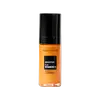What's inside
What's inside
 Key Ingredients
Key Ingredients

 Benefits
Benefits

 Concerns
Concerns

 Ingredients Side-by-side
Ingredients Side-by-side

Propanediol
SolventAlcohol Denat.
AntimicrobialWater
Skin ConditioningGlycerin
Humectant3-O-Ethyl Ascorbic Acid
Skin ConditioningPropylene Carbonate
SolventHydroxypropylcellulose
EmulsifyingParfum
MaskingLinalool
PerfumingPalmaria Palmata Extract
Skin ProtectingLimonene
PerfumingGeraniol
PerfumingBakuchiol
AntimicrobialBenzyl Benzoate
AntimicrobialPhenoxyethanol
PreservativeCitral
PerfumingCitronellol
PerfumingHexyl Cinnamal
PerfumingBenzyl Alcohol
PerfumingWater
Skin ConditioningAscorbyl Methylsilanol Pectinate
AntioxidantPropanediol
SolventGlycerin
Humectant3-O-Ethyl Ascorbic Acid
Skin ConditioningSilica
AbrasiveParfum
MaskingGlucosyl Hesperidin
HumectantSodium PCA
HumectantAnogeissus Leiocarpa Bark Extract
Skin ConditioningSodium Hyaluronate
HumectantTocopherol
AntioxidantBeta-Carotene
Skin ConditioningBisabolol
MaskingAdenosine
Skin ConditioningSaccharide Isomerate
HumectantSodium Lactate
BufferingCitric Acid
BufferingGlyceryl Caprylate
EmollientXanthan Gum
EmulsifyingCaprylic/Capric Triglyceride
MaskingSclerotium Gum
Emulsion StabilisingGlycine Soja Oil
EmollientPolyglyceryl-2 Dipolyhydroxystearate
Skin ConditioningZea Mays Starch
AbsorbentPhytic Acid
Biosaccharide Gum-2
Skin ConditioningSodium Citrate
BufferingLauryl Glucoside
CleansingLaminaria Ochroleuca Extract
Skin ConditioningWater, Ascorbyl Methylsilanol Pectinate, Propanediol, Glycerin, 3-O-Ethyl Ascorbic Acid, Silica, Parfum, Glucosyl Hesperidin, Sodium PCA, Anogeissus Leiocarpa Bark Extract, Sodium Hyaluronate, Tocopherol, Beta-Carotene, Bisabolol, Adenosine, Saccharide Isomerate, Sodium Lactate, Citric Acid, Glyceryl Caprylate, Xanthan Gum, Caprylic/Capric Triglyceride, Sclerotium Gum, Glycine Soja Oil, Polyglyceryl-2 Dipolyhydroxystearate, Zea Mays Starch, Phytic Acid, Biosaccharide Gum-2, Sodium Citrate, Lauryl Glucoside, Laminaria Ochroleuca Extract
 Reviews
Reviews

Ingredients Explained
These ingredients are found in both products.
Ingredients higher up in an ingredient list are typically present in a larger amount.
You might know this ingredient as Ethyl Ascorbic Acid, a more stable version of ascorbic acid.
Like other types of vitamin C, this ingredient has many benefits including reducing wrinkles, skin soothing, dark spot fading, and fighting against free radicals.
3-O-Ethyl Ascorbic Acid interferes with the process of skin darkening, helping to reduce hyperpigmentation. It also encourages the skin to produce more collagen.
Once applied, 3-O-Ethyl Ascorbic Acid is converted to Vitamin C deeper in the skin's layers. This process is slow but makes this ingredient more tolerable for skin.
The optimum pH range for this ingredient is 4 - 5.5
Learn more about 3-O-Ethyl Ascorbic AcidGlycerin is already naturally found in your skin. It helps moisturize and protect your skin.
A study from 2016 found glycerin to be more effective as a humectant than AHAs and hyaluronic acid.
As a humectant, it helps the skin stay hydrated by pulling moisture to your skin. The low molecular weight of glycerin allows it to pull moisture into the deeper layers of your skin.
Hydrated skin improves your skin barrier; Your skin barrier helps protect against irritants and bacteria.
Glycerin has also been found to have antimicrobial and antiviral properties. Due to these properties, glycerin is often used in wound and burn treatments.
In cosmetics, glycerin is usually derived from plants such as soybean or palm. However, it can also be sourced from animals, such as tallow or animal fat.
This ingredient is organic, colorless, odorless, and non-toxic.
Glycerin is the name for this ingredient in American English. British English uses Glycerol/Glycerine.
Learn more about GlycerinParfum is a catch-all term for an ingredient or more that is used to give a scent to products.
Also called "fragrance", this ingredient can be a blend of hundreds of chemicals or plant oils. This means every product with "fragrance" or "parfum" in the ingredients list is a different mixture.
For instance, Habanolide is a proprietary trade name for a specific aroma chemical. When used as a fragrance ingredient in cosmetics, most aroma chemicals fall under the broad labeling category of “FRAGRANCE” or “PARFUM” according to EU and US regulations.
The term 'parfum' or 'fragrance' is not regulated in many countries. In many cases, it is up to the brand to define this term.
For instance, many brands choose to label themselves as "fragrance-free" because they are not using synthetic fragrances. However, their products may still contain ingredients such as essential oils that are considered a fragrance by INCI standards.
One example is Calendula flower extract. Calendula is an essential oil that still imparts a scent or 'fragrance'.
Depending on the blend, the ingredients in the mixture can cause allergies and sensitivities on the skin. Some ingredients that are known EU allergens include linalool and citronellol.
Parfum can also be used to mask or cover an unpleasant scent.
The bottom line is: not all fragrances/parfum/ingredients are created equally. If you are worried about fragrances, we recommend taking a closer look at an ingredient. And of course, we always recommend speaking with a professional.
Learn more about ParfumPropanediol is an all-star ingredient. It softens, hydrates, and smooths the skin.
It’s often used to:
Propanediol is not likely to cause sensitivity and considered safe to use. It is derived from corn or petroleum with a clear color and no scent.
Learn more about PropanediolWater. It's the most common cosmetic ingredient of all. You'll usually see it at the top of ingredient lists, meaning that it makes up the largest part of the product.
So why is it so popular? Water most often acts as a solvent - this means that it helps dissolve other ingredients into the formulation.
You'll also recognize water as that liquid we all need to stay alive. If you see this, drink a glass of water. Stay hydrated!
Learn more about Water